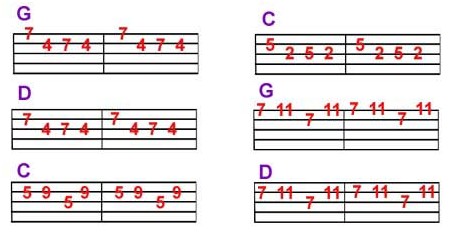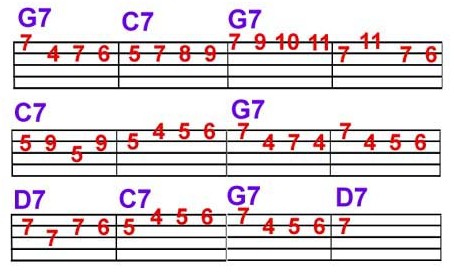







© 2011 Bob Culbertson
Walking Bass Lines
In this lesson we will learn how to construct walking bass lines. First we begin with the 3 basic parts of a chord (Root, 3rd, and 5th). Practice the exercises below to get a feel for the chord tones. Remember the tablature is for the bass side and the chord symbols represent the chords you are playing the parts of. You do not need to play the chords in the melody hand at first. Play the bass notes as 1/4 notes at a steady tempo. Shown here are 2 different ways to play the same notes for each chord. You will need to be able to move in different directions on the fingerboard for smooth execution of the walking bass.
In this lesson we will learn how to construct walking bass lines. First we begin with the 3 basic parts of a chord (Root, 3rd, and 5th). Practice the exercises below to get a feel for the chord tones. Remember the tablature is for the bass side and the chord symbols represent the chords you are playing the parts of. You do not need to play the chords in the melody hand at first. Play the bass notes as 1/4 notes at a steady tempo. Shown here are 2 different ways to play the same notes for each chord. You will need to be able to move in different directions on the fingerboard for smooth execution of the walking bass.

FIG 1
Now we will put a bass line together. The trick is to play ascending and decending lines by starting on the root of each chord and playing notes in between the parts of each chord as you go from one note in the chord to the next. If this sounds confusing, I have decided to write down one complete bass line for a 12 bar blues.
Notice the bass line begins on the root of the chord unless the chord lasts for 2 measures. I try to make the bass line move smoothly up and down without jumping around too much. I also try to emphasize the parts of each chord by using the 3rd and 5th a lot.
Also take note of the "leading tones". Leading tones are played 1/2 step above or below the root of the next chord on the last beat of the previous measure. There are leading tones on the 4th beat of the 1st, 4th, 6th, 8th, 9th, 10th & 11th measures. All the bass notes are 1/4 notes. Play as evenly as you can.
Notice the bass line begins on the root of the chord unless the chord lasts for 2 measures. I try to make the bass line move smoothly up and down without jumping around too much. I also try to emphasize the parts of each chord by using the 3rd and 5th a lot.
Also take note of the "leading tones". Leading tones are played 1/2 step above or below the root of the next chord on the last beat of the previous measure. There are leading tones on the 4th beat of the 1st, 4th, 6th, 8th, 9th, 10th & 11th measures. All the bass notes are 1/4 notes. Play as evenly as you can.
FIG 2


Remember walking bass is like improvising, you do not have to be to strict about what you play. Once you master the example try experimenting with changing some of the notes in the pattern. Eventually you will be able to do this as you play. A good way to learn to improvise the bass line is to learn the shape (pattern) of the chord tones (Root, 3rd & 5th) in the bass hand first. After you master this technique next experiment with starting some of the measures on other parts of the chord.